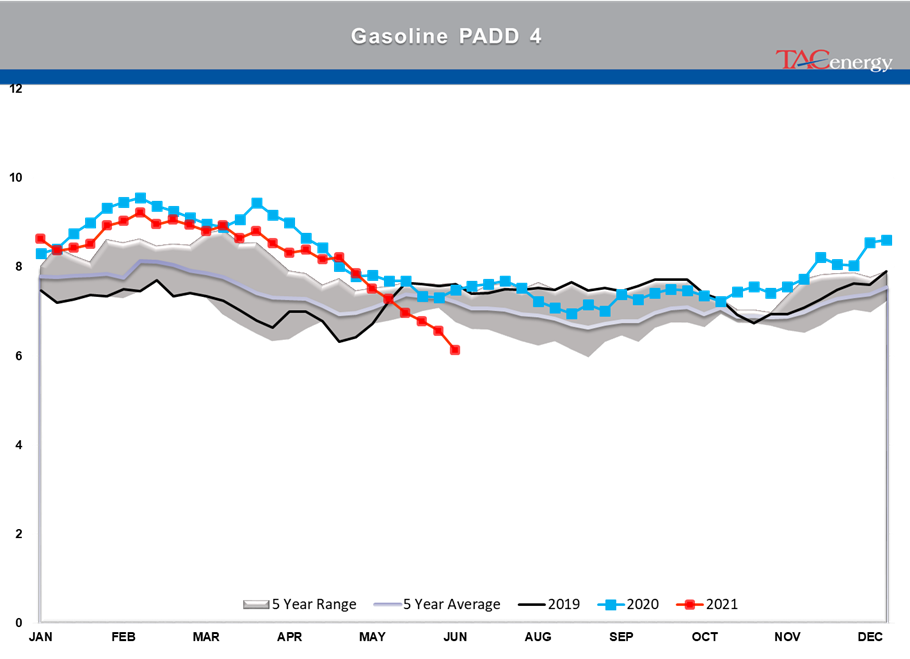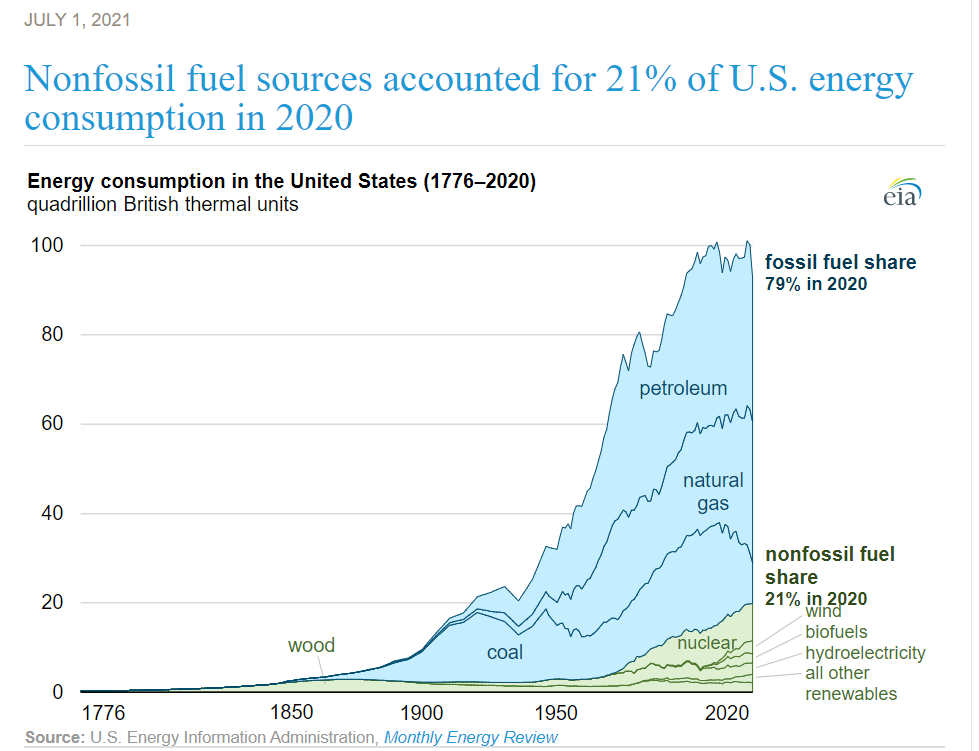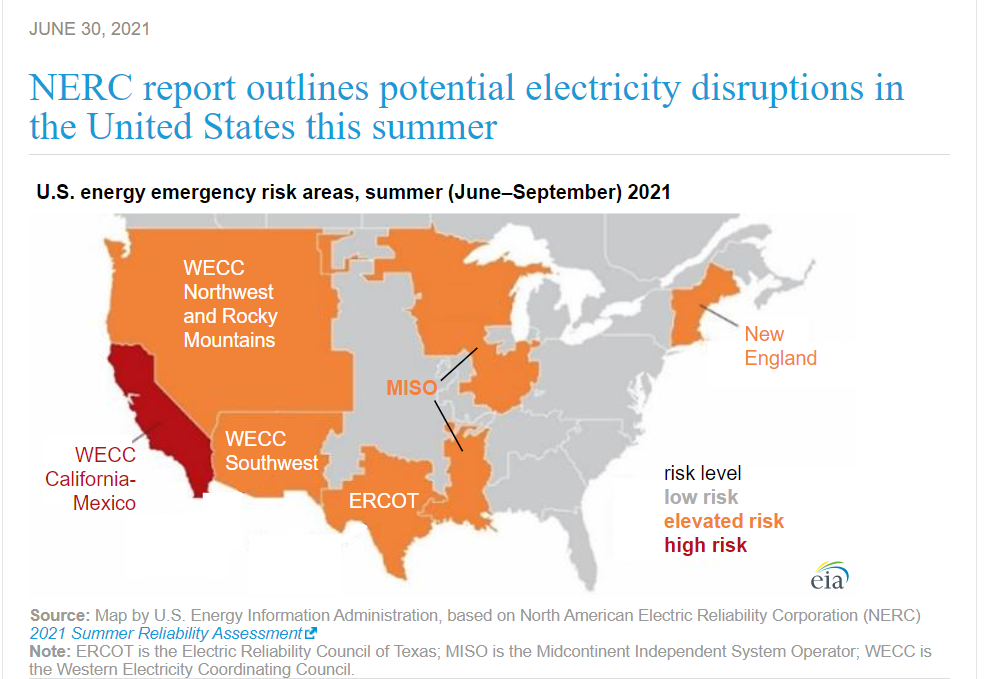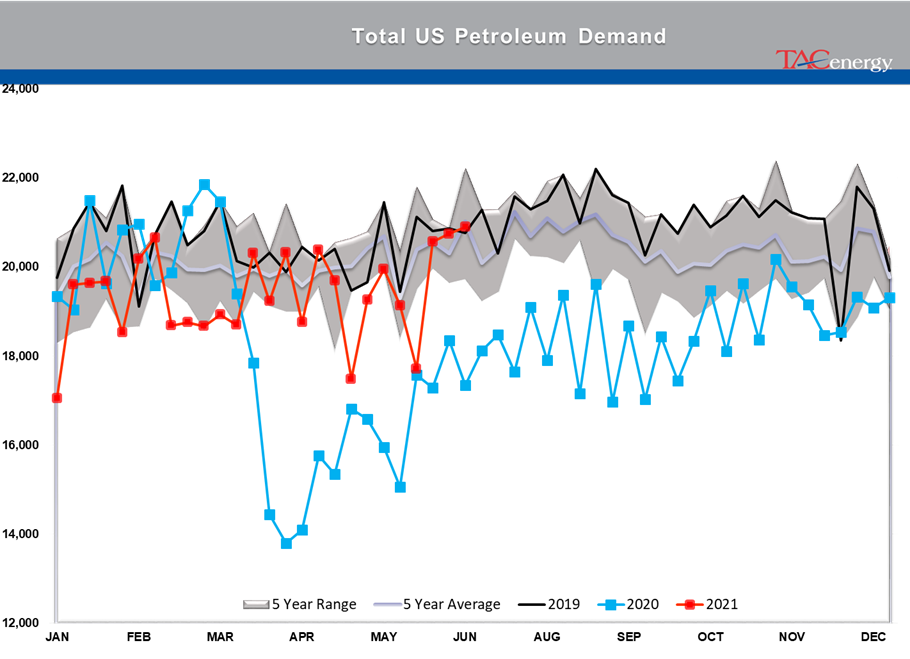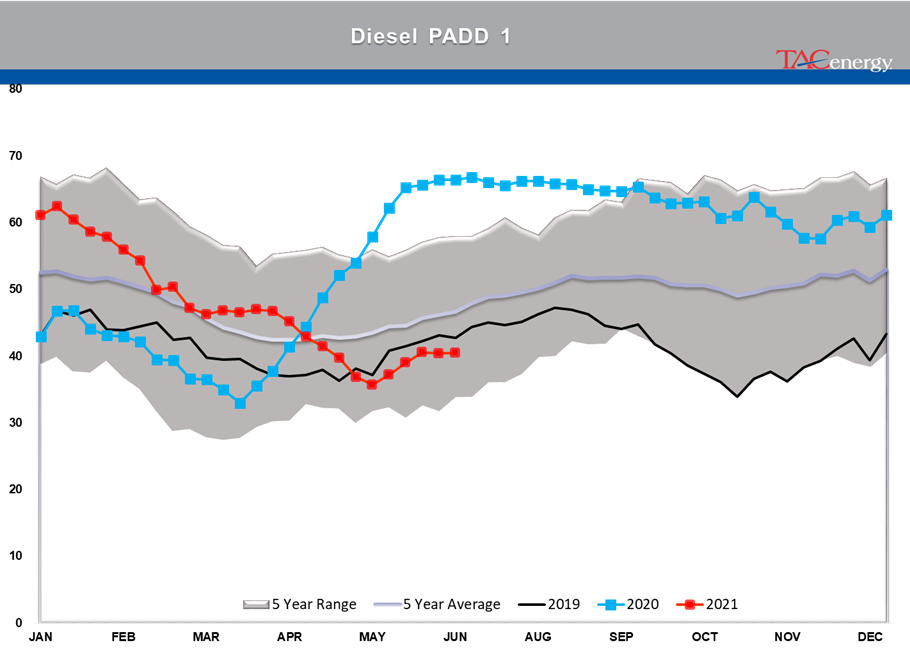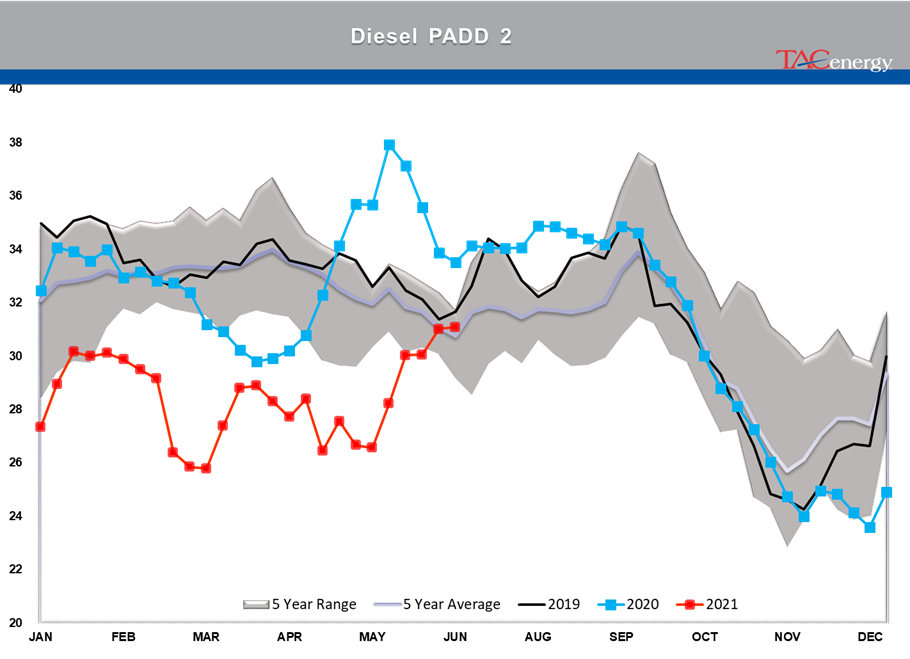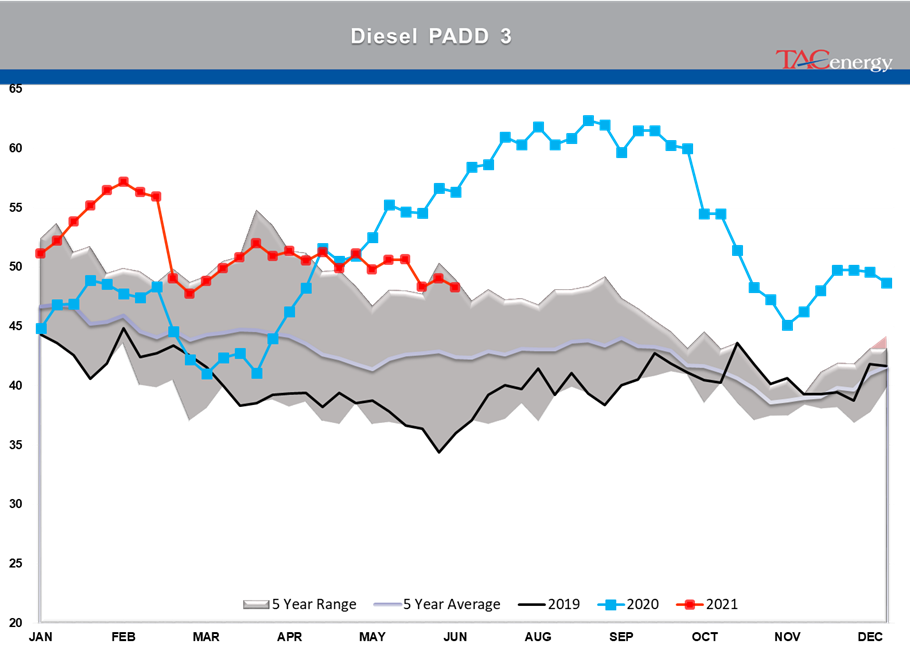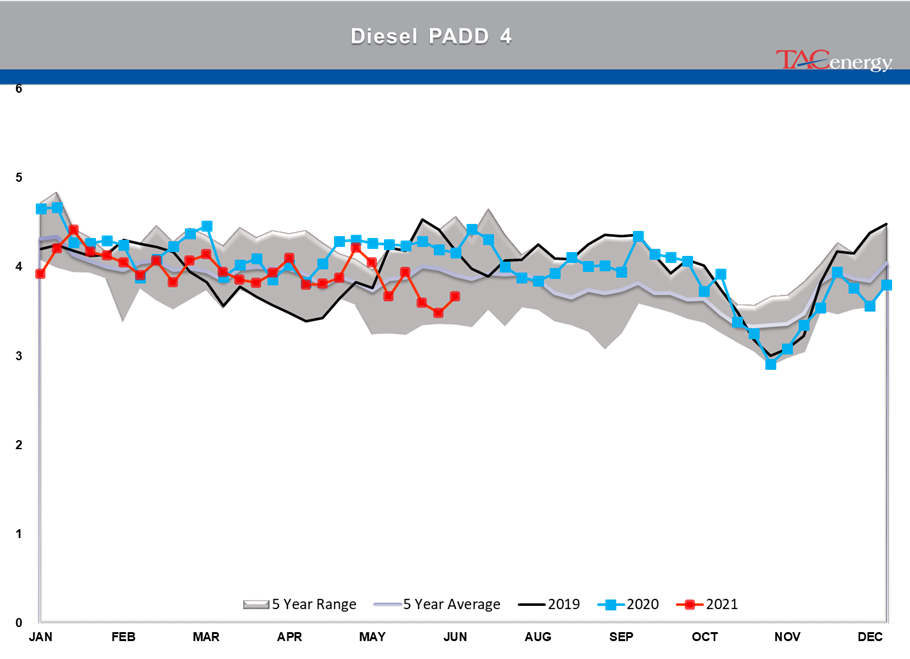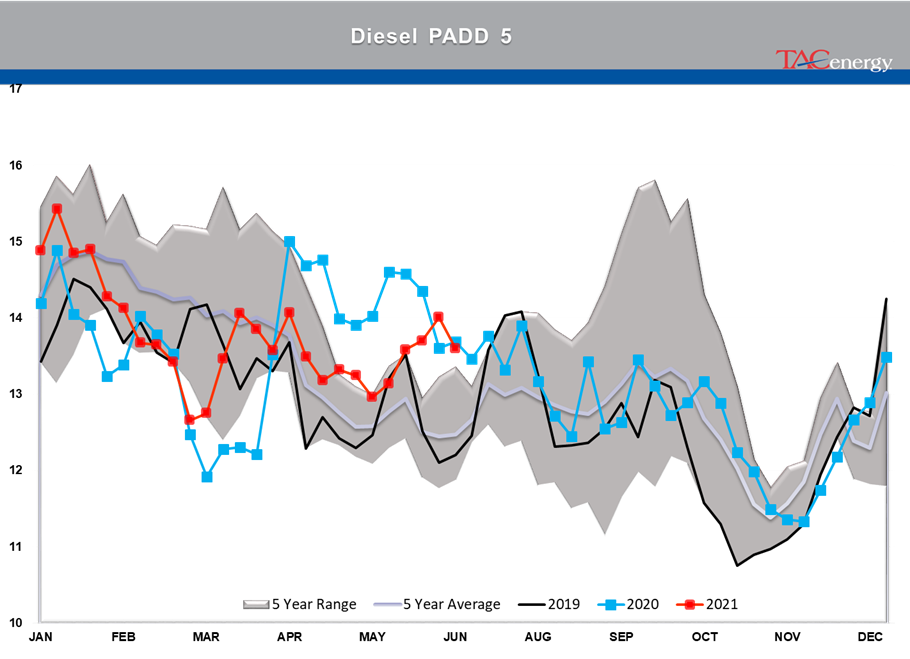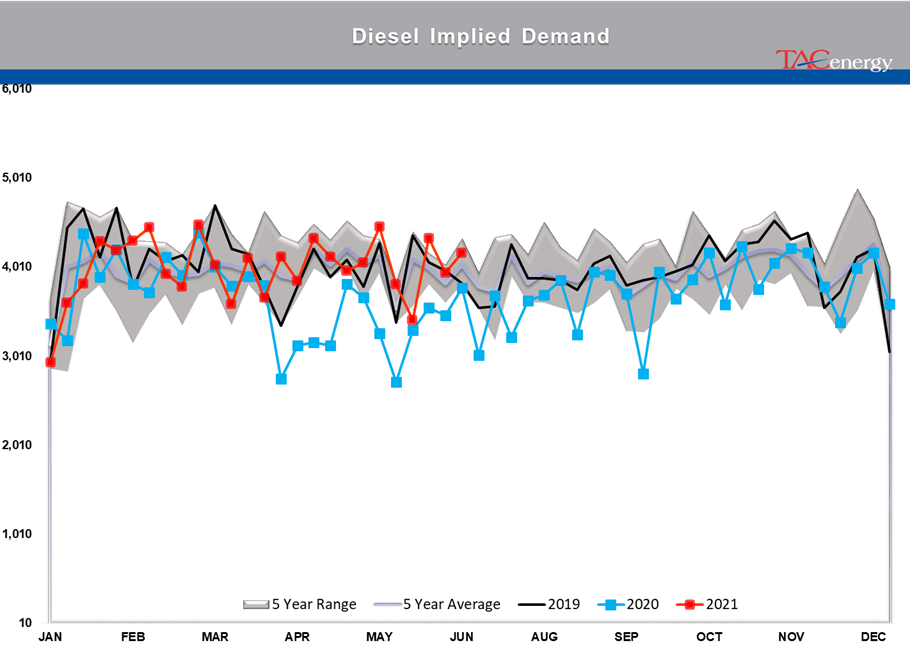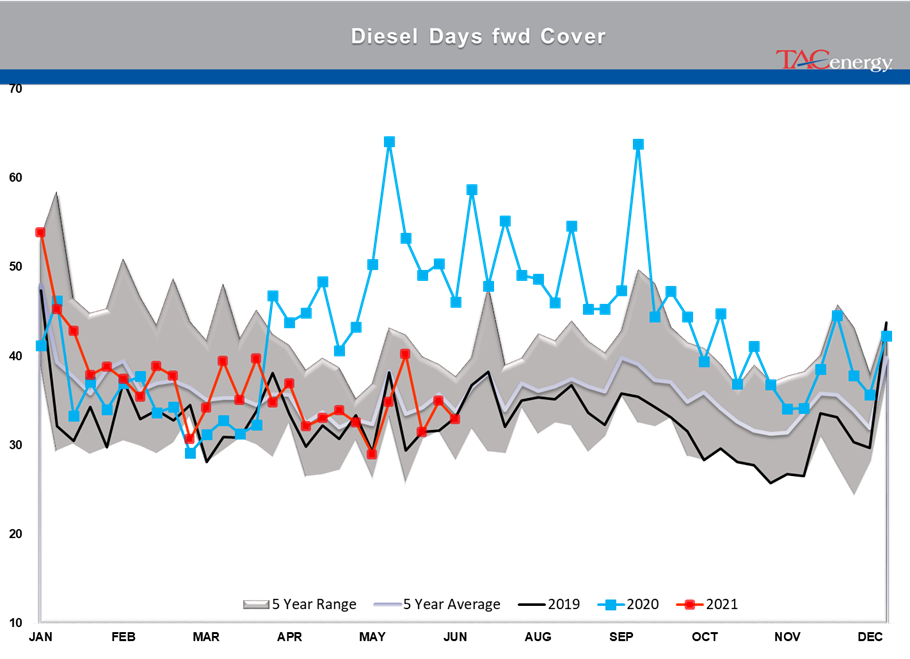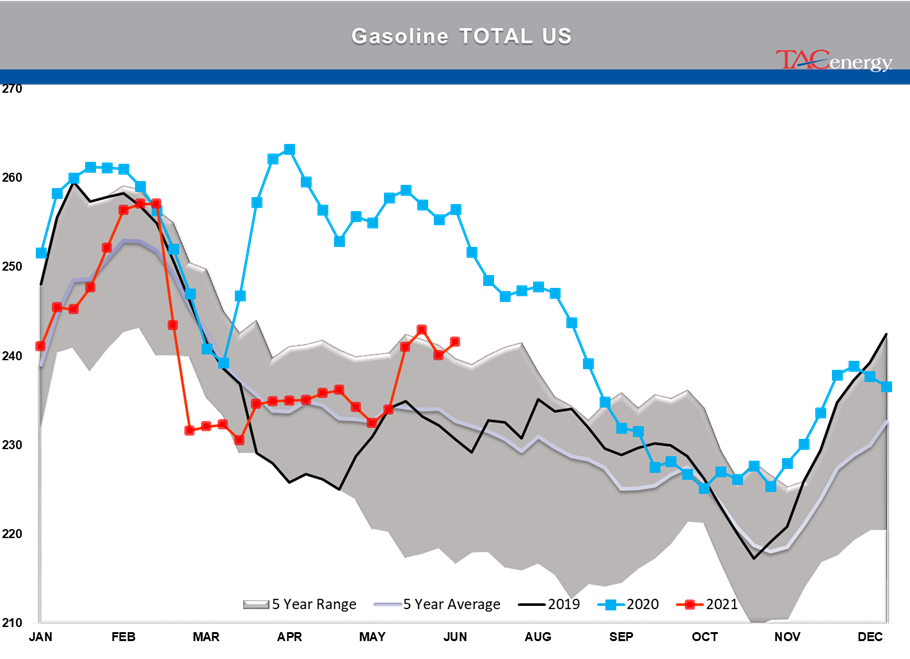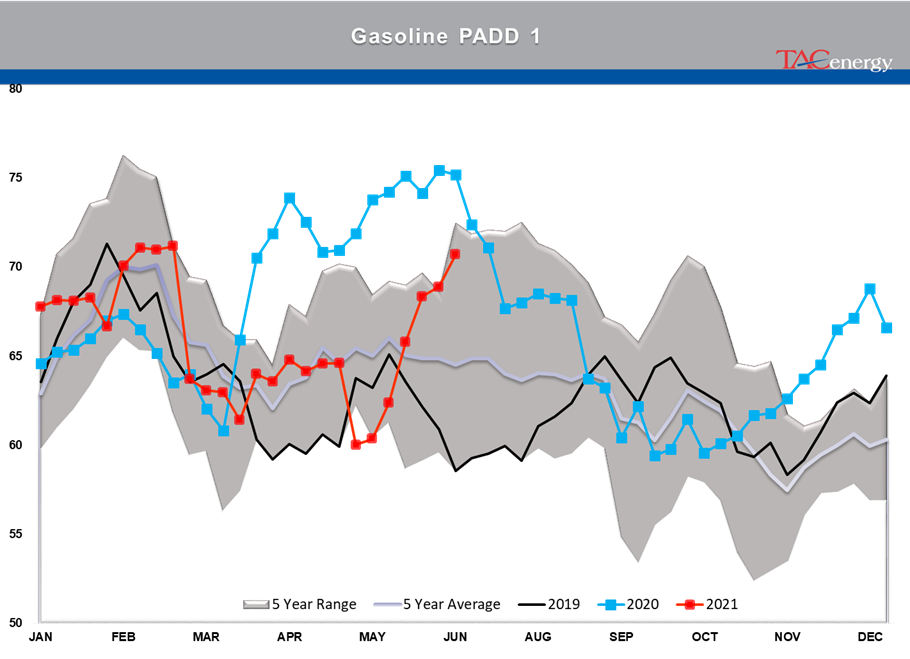A Strong Start To July

It’s a strong start to July with refined products rallying more than a nickel in the early going, and crude oil prices reaching fresh 2.5 year highs. The OPEC meeting is underway and will likely create some volatility today as rumors start trickling out of the meeting ahead of the official announcement.
Tropical storm Elsa has formed in the Atlantic, and looks like it will hit Florida early next week. It’s still early in the season so the waters haven’t reached their warmest levels yet which should keep this storm from reaching hurricane strength. The forecast cone currently keeps the storm east of the oil refining and production region of the Gulf of Mexico, and if that holds, this should not be a supply threat beyond some headaches in the ports as the storm passes.
Wednesday’s DOE report added to the bullish sentiment for oil as US inventories saw another large decline, a 6th straight week of falling inventories, and one of the largest monthly declines on record. Total US Petroleum demand climbed for a third straight week and is holding above its seasonal average for this time of year. The exception in the report was gasoline, which saw a drop in the weekly demand estimate and a build in inventories. The DOE also reduced its gasoline demand estimates from the spring in its latest monthly update, although that’s done little to stop the rally as RBOB futures just reached their highest level in nearly 7 years in the past few minutes.
The exception to the weaker gasoline fundamentals is the PADD 4, which has by far the fewest people and thus the least amount of gasoline of the districts and is typically ignored in the weekly statistics given its volume amounts to a rounding error. This week however it could be the canary in the coal mine for the industry as it deals with the resumption in demand following so many refinery closures in the past year. Regional inventories have dropped to their lowest levels in nearly a decade as Colorado’s sole refinery struggles through a turnaround, and 2 of the main backup options nearby are no longer operating as oil refineries.
RINs have been uncharacteristically quiet the past couple of days after the Supreme Court ruling rippled through the market Friday and Monday. That relative lack of volatility may not last long however as grain prices saw a strong rally following the USDA’s crop report which showed fewer acres planted than many reports expected, setting the stage for stronger values in the back half of the week.
Abandoning ship: Shell continues to shed assets, with a sale of its share in a California production JV coming according to a new Reuters report. Meanwhile, Chevron is looking to sell some of its stake in the Permian, which should provide a good test of the new theory that US producers are showing discipline in their spending even now that prices are near 3 year highs pushing companies back into the black.
The EIA this morning published a note highlighting that non-fossil fuel sources reached 21% of total energy consumption in the US last year, the highest levels in more than a century, when wood was the renewable energy of choice. The report does point out that Nuclear power remains the largest non-fossil fuel category by usage, while petroleum’s share has held relatively steady the past several years. Those various sources of energy are facing multiple tests this week as temperatures & electricity usage have surged from coast to coast.
Another EIA report yesterday highlighted vulnerable areas of the country’s power grid this summer, with the majority of the country listed as an elevated or high risk of outage. New York was one of the relatively few states given a low risk status in the report, and right on cue, government officials are calling for conservation this week as the heat wave is giving their grid a tough test.
Click here to download a PDF of today’s TACenergy Market Talk.
Latest Posts
Markets Rallying To End The Week, Diesel Prices Lead The Way For Energy
Energy Markets Rally Again Thursday After A Choppy Wednesday Session
Week 16 - US DOE Inventory Recap
Energy Markets Trading Quietly In The Red As Ethanol Prices Rally To Five-Month High
Social Media
News & Views
View All
Markets Rallying To End The Week, Diesel Prices Lead The Way For Energy
Energy markets are rallying to end the week, with diesel prices leading the way up 2.5 cents in the early going. Equity markets are also rallying after a big Thursday selloff as strong tech earnings seem to be outweighing the FED’s favorite inflation gauge remaining stubbornly high.
RBOB gasoline futures are trading higher for a 4th straight day, but despite bouncing nearly 14 cents from Tuesday’s low, they still need to rally another nickel to break the downward sloping pattern forming on the weekly charts. Seasonal factors could go either way for gasoline for the next few weeks as we’re in the Spring peaking window, and while the high set April 12th would fit the annual pattern nicely, a May price peak is certainly not unusual, and if $2.85 is broken it seems like RBOB will run to $3 in a hurry.
Diesel prices have bounced 7 cents after touching a 5-month low on Monday but need to climb back above $2.60 to reduce the chance of a slide to $2.20 or lower should the chart support around $2.50 break down.
Back to the shadow war: After a relatively quiet few weeks in the Red Sea, Houthi attacks on ships have started again over the past few days, although so far, no major damage has been reported.
ExxonMobil reported another strong quarter in Q1 with more than $10 billion in free cash flow generated, even though earnings in its refining segment were down 67% from the first quarter of last year. The company noted the success of its Beaumont refinery expansion that came online last year and marked the only major refinery expansion in the US in over a decade. It's worth noting that within the refining segment, international earnings suffered more than domestic facilities did, with non-US refining earnings down 77% from a year ago as crack spreads came back to reality after the record-setting quarters in 2022 and 2023.
Chevron followed a similar pattern (as expected) in its Q1 report, noting strong operating cash flows of $6.8 billion in total, despite downstream earnings falling more than 56% for the quarter.
The company also highlighted its expanding marketing network along the US West and Gulf Coast markets encompassing more than 250 retail stations and highlighted its new solar-to-hydrogen project in California.
Phillips 66 continued the trend, reporting a “strong” quarter in which earnings were 63% lower than a year ago. The company highlighted the conversion of its Rodeo refinery which is now producing roughly 30mb/day of RD and is expected to ramp up to 50mb/day in the 2nd quarter. That facility had a capacity of more than 120mb/day prior to its conversion, and it used to produce gasoline along with its diesel. The company also noted its ongoing plans to sell assets that no longer fit its strategy, highlighting retail assets in Germany and Austria as being on the chopping block, while not mentioning any of its US refining assets that have long been rumored to be for sale.
Delek reported another upset at its Alon Big Spring refinery Thursday, which has become another one of the TCEQ’s frequent fliers after suffering damage from the cold snaps in both 2021 and earlier this year.
A harsh reality sinking in: Mexico’s President has made plenty of headlines with fictitious claims of energy sovereignty in the past few years, but not only is the country’s new Dos Bocas refinery still not producing finished products on any sort of meaningful scale, two of its other facilities have suffered fires recently forcing the country to import even more product from the US. This phenomenon continues to help US Gulf and West coast refiners who would be struggling (even more) to move their excess with sluggish domestic demand.
Click here to download a PDF of today's TACenergy Market Talk.

Energy Markets Rally Again Thursday After A Choppy Wednesday Session
Energy markets are trying to rally again Thursday after a choppy Wednesday session. RBOB gasoline futures are leading the push higher, on pace for a 3rd consecutive day of gains after finding a temporary floor Tuesday and have added 12 cents from those lows.
Equity markets are pointing sharply lower after a weak Q1 GDP estimate which seems to have contributed to a pullback in product prices over the past few minutes, but don’t be surprised if the “bad news is good news” low interest rate junkies start jumping in later on.
The DOE’s weekly report showed sluggish demand for gasoline and diesel, but inventory levels in most markets continue to follow their typical seasonal trends. Refinery runs held fairly steady last week with crude inputs down slightly but total gross throughputs up slightly as most facilities are now back online from a busy spring maintenance season and geared up for peak demand this summer.
Propane and propylene exports spiked to a record high north of 2.3 million barrels/day last week, which demonstrates both the US’s growing influence on global product markets, and the steady shift towards “other” products besides traditional gasoline and diesel in the level of importance for refiners.
The EIA acknowledged this morning that its weak diesel consumption estimates reflected the switch to Renewable Diesel on the West Coast, although they did not provide any timeline for when that data will be included in the weekly survey. The agency acknowledged that more than 4% of the total US consumption is now a combination of RD and Biodiesel, and that number is expected to continue to grow this year. This morning’s note also suggested that weak manufacturing activity was to blame for the sluggish diesel demand across the US, while other reports suggest the freight recession continued through Q1 of this year, which is also contributing to the big shift from tight diesel markets to oversupplied in several regions.
Valero kicked off the Q1 earnings releases for refiners with solid net income of $1.2 billion that’s a far cry from the spectacular earnings north of $3 billion in the first quarter of 2023. The refining sector made $1.7 billion, down from $4.1 billion last year. That is a pattern that should be expected from other refiners as well as the industry returns to a more normal market after 2 unbelievable years. You wouldn’t guess it by looking at stock prices for refiners though, as they continue to trade near record highs despite the more modest earnings.
Another pattern we’re likely to see continue with other refiners is that Renewable earnings were down, despite a big increase in production as lower subsidies like RINs and LCFS credit values sting producers that rely on those to compete with traditional products. Valero’s SAF conversion project at its Diamond Green joint venture is progressing ahead of schedule and will give the company optionality to flip between RD and SAF depending on how the economics of those two products shakes out this year. Valero also shows part of why refiners continue to disappear in California, with operating expenses for its West Coast segment nearly 2X that of the other regions it operates in.

